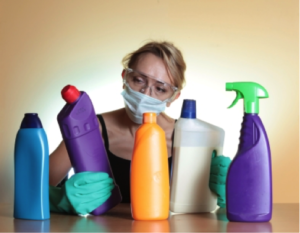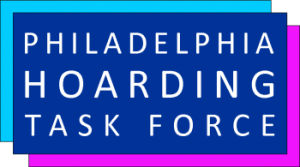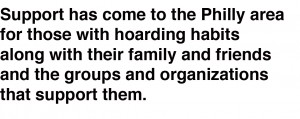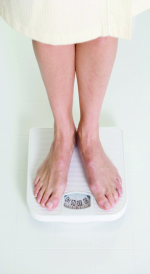 Most of us haven’t taken a close look at the chemical content of our common household cleaners, skin care products and makeup to find out that there are dangerous chemicals lurking in the ingredients list. The next time you are clearing out your cabinets by yourself or with one of us, Professional Organizers, don’t just look at the expiration dates, check the ingredients and keep the information below in mind.
Most of us haven’t taken a close look at the chemical content of our common household cleaners, skin care products and makeup to find out that there are dangerous chemicals lurking in the ingredients list. The next time you are clearing out your cabinets by yourself or with one of us, Professional Organizers, don’t just look at the expiration dates, check the ingredients and keep the information below in mind.
I went to a meeting hosted by Physicians for Social Responsibility, a group that looks at potential hazards facing our society. At the meeting, they showed a short video by Annie Leonard called the “Story of Cosmetics.” The video was followed by a discussion questioning the pervasive use of toxic chemicals in our beauty products, from lipstick to baby shampoo, chemicals that are known to contain carcinogens, neurotoxins, reproductive toxins and heavy metals, like lead and mercury. I was shocked to find out that lipsticks contain lead. Although I understand that it is hard to live in a lead free world, as Annie Leonard questions, “Do we have to put lead in our lipsticks?” I even found this to be the case when I went searching for new lipsticks in Whole Foods in the “organic” cosmetic department!
Harmful chemicals are not just in our cosmetic bags. Our homes are filled with fumes from harmful petrochemical solvents that are added to everyday house cleaners. “The average household contains anywhere from 3 to 25 gallons of toxic materials, most of which are in cleaners,” notes Ava Anderson, a young entrepreneur, who at age 14 went in search of personal care products that did not contain harmful chemicals and couldn’t find any. In response, Ava started her own company selling healthier choices for skin care and cleaning products. At the heart of her company is a commitment to educate the public about the chemical content in products we use without worry or concern for their potential cumulative and lasting effects to our health and wellbeing.
Like Annie Leonard, Ava’s research finds disturbing facts that most of us do not know, facts that might shape our buying habits moving forward. Below are highlights from Ava’s list:
Below are Gaiam Life’s “8 Household Cleaning Agents to Avoid” and why:
The “All You” website also has a list of 6 chemical hazards hiding in your home, for those of you who are interested in more information.
If like me, after confronting this information, you’re heading to your cupboards, toiletry bags and makeup kit to do some tossing, the next question would be, “then what can I use instead?” Below are suggestions to get you started using baking soda, white vinegar, fresh lemons and coconut oil.
Baking Soda
Here are suggested uses for baking soda from The Farmer’s Almanac and “All You” websites:
White Vinegar
White vinegar can replace many common cleaning products you now may want to avoid. Here are suggestions from the “All You” website:
Lemons
Lemons offer alternatives to both cleaning products and beauty care. Here are suggestions from the “All You” website:
Coconut Oil
Coconut is the newest addition to my healthier cabinets & toiletry bag. Here are some of my favorites uses from the “Derm Store.”
Well, I hope you found some good, enticing alternative product ideas for your mop closet and makeup bag. It has been fun trying out and discovering healthier products and now, sharing them with all of you. May you too enjoy your journey towards healthier products.
 As a follow-up to my blog post from last year at this time, I am thrilled to report that the Philadelphia Hoarding Task Force (PHTF) is in its second year and making headway.
As a follow-up to my blog post from last year at this time, I am thrilled to report that the Philadelphia Hoarding Task Force (PHTF) is in its second year and making headway.
In 2013, the Philadelphia Hoarding Task Force a coalition of organizations dedicated to increasing access to services for people with hoarding behavior, created a bold mission:
“To improve outcomes for people who hoard and reduce the catastrophic consequences related to hoarding for residents of the City of Philadelphia.”
An ambitious undertaking to say the least!
In its first year, PHTF had four major accomplishments:
1. Resource Guide – This guide offers immediate and non-immediate resources that may help a person with hoarding behaviors live a safer, healthier life. It can also be used by organizations that have clients who have hoarding behaviors. Please click the link for further details Resource Guide.
2. Helplines – Assist those with questions regarding hoarding-related issues in the Philadelphia area.
Under 60 years of age: 215-751-1800
60 years of age and above: 215-545-5728
3. Website and Social Media Presence –
www.philadelphiahoarding.org
Like PHTF on Facebook
Follow PHTF on Twitter
4. Educational Workshops – “Introduction to Hoarding Workshop”
This workshop is presented by one of PHTF’s Education Committee members and is offered free of charge to the public. These workshops are listed on the website.
Arrangements can be made to have an “Introduction to Hoarding Workshop” done for a specific group or organization that serves the Philadelphia community. Email PHTF at .
Standing on the accomplishments of 2014, the Philadelphia Hoarding Task Force is working to expand its services to include case management, support groups, therapy and cleaning services. The 2015 goals for PHTF are to:
A statistic listed on the PHTF website notes that individuals with hoarding behaviors account for two to five percent of the population—an estimated 23,600 to 59,000 adults in Philadelphia. These numbers are alarming and reveal the need to address this issue individually and as a community.
The approach of the PHTF is based on three key principles:
1. To focus on the person, not the problem or the items they hoard. At the heart of their work is an awareness that behind every hoarded home is a person who needs help, not judgment. They require patience and respect from everyone involved.
2. Since there can be serious consequences for people who hoard because hoarding can be a serious hazard, PHTF advocates solutions that will help resolve emergency issues while also providing support over time.
3. PHTF seeks a balance between the rights of the individual to live as they choose with the needs of the community. PHTF believes that hoarding goes from being an individual struggle to a community problem when it threatens health, safety and livability for those living in a hoarded home, their neighbors, and also the service providers, contractors, and emergency responders entering a hoarded home.
In short, PHTF works to provide individuals and organizations in the region with the tools they need to successfully overcome the challenges associated with hoarding behavior and the public safety hazards that may result.
May the ‘Force’ be with the Philadelphia Hoarding Task Force again this year as it continues to make headway through these uncharted waters!

Along with four other Professional Organizers, I had the opportunity to attend a meeting of the Philadelphia Hoarding Task Force and was excited to find out that we are NOT ALONE!
The result of hoarding behaviors touches countless lives. The most obvious is the lives of those with hoarding habits, those who live with them, their children, family members, and close friends. Maybe, less obvious, is the effect of this life style on their surrounding communities. Often times there have been multiple attempts to deal with and support those with hoarding habits resulting in little change and outcomes that don’t last long. Interventions usually focus on having the person divest themselves of things that clutter their living spaces. Frustration, hard feelings are the typical results as little seems to penetrate the multifaceted web of commingled issues, emotions and unrelenting habits that have, more likely than not, spanned the individual’s life time.
This particular and persistent practice of collecting is the manifestation of a complex network of interpretations for the person who engages in hoarding behaviors. For many who are observing these hoarding tendencies, it is virtually impossible to understand, decipher, and make sense of the complexities involved in the condition. Working side by side with clients who engage in hoarding behaviors, I have heard very elaborate and creative explanations for their holding on to what looks like, to anyone else, seemingly useless items. Their ‘need’ to save things is logical in their view, however, the result of their logic is counterproductive to their desire to alleviate their situation that impacts themselves, their loved ones, and in some cases, their community.
Because the result of hoarding behaviors looks like disorganization and clutter, at first glance, it would seem like working with hoarding situations is perfectly suited for the organizing profession. Initially, that was the thinking of the pioneers of our profession until they began to notice that successful organizing methodologies, principles, and products did not seem to work with certain clients. During those early years, organizers tried to impact situations where shower rods became alternate hanging spaces for clothes, dining room tables became storage for piles of papers often flowing over to the accompanying chairs, and beds housed everything else leaving little to no room for the owner. The result, a sub group of NAPO was birthed. Back then it was called NSGCD (The National Study Group on Chronic Disorganization). Today, it is its own independent organization called The Institute for Challenging Disorganization (www.ChallengingDisorganization.org). Their mission is to provide education, research, and strategies to benefit people challenged by chronic disorganization.
Working with these situations for the past 11 years as well as being a member of NAPO and ICD, I have learned that simply talking about the ‘stuff’ with clients is limiting and often times futile. Getting to the reasons and explanations for their need to hold on to items helps to unlock the interpretation that justifies their hoarding behaviors and often times can loosen the grip of their ‘need’ to hold on to things. However, delving into the root cause of these tendencies is outside an organizer’s skill set and training. Teaming up with other professionals such as social workers and therapists, offers more hope for longer-lasting results.
Finding these opportunities to team up with other professionals working with people challenged with chronic disorganization has not been easy until recently when the Greater Philadelphia Chapter of NAPO (NAPO-GPC) was contacted and invited to participate on the Philadelphia Hoarding Task Force. An impressive list of local organizers accepted the invitation, and it was love at first meeting! Finally, we are NOT ALONE in our work with these clients!
Still in its infancy, the mission of the Philadelphia Hoarding Task Force, co-chaired by David Wengert from the Community Legal Services and Katherine Martin, Deputy Policy Director from the Mayor’s office, is to “ensure positive outcomes for those individuals who are impacted by hoarding.” Although the Task Force does not provide direct services, its role is to ensure access to resources, training for provider organizations, and education about hoarding in Greater Philadelphia”. The meeting that I attended with four of my collogues was comprised of representatives from the Philadelphia Police and Fire Department, Licenses & Inspections, Philadelphia Corporation for Aging, and Clutterers Anonymous, to name a few. Each of the representatives brought their unique perspective to the meeting. The shared conclusions was that the work of the Task Force should focus on the individual, not the problem, i.e. the ‘stuff’ and that this perspective should permeate all efforts made by the Task Force, especially in the educational trainings it provides.
A shared understanding of the complexity that leads to hoarding behaviors among the organizations that confront these circumstances, along with sharing resources, expertise, accountabilities, and services, was music to all of our ears!
Finally, we as organizers, can say, we are NOT ALONE in our work with clients who are struggling with habits of hoarding! Collaborating with other professionals helps us offer those challenged by hoarding habits a more holistic service approach, and a hopeful future.
Suggested Resources:
 As I was driving the other day listening to NPR, I heard a provocative story suggesting that researchers should stop spending millions of dollars comparing the content of all the various diets programs on the market today. Instead, they should focus their studies on how to effectively change behaviors associated with weight gain. As a Professional Organizer, this piqued my interest.
As I was driving the other day listening to NPR, I heard a provocative story suggesting that researchers should stop spending millions of dollars comparing the content of all the various diets programs on the market today. Instead, they should focus their studies on how to effectively change behaviors associated with weight gain. As a Professional Organizer, this piqued my interest.
Featured on the NPR program “Here And Now,” was Carey Goldberg, health reporter for WBUR in Boston, commenting on a recent paper published in the Journal of the American Medical Association. Analyzing different well-known diet programs, the report concluded that the various diet programs — on average — are equally well suited for losing weight. Therefore, one could pick and choose any one of the diet programs that looks appealing to them and get pretty much the same result.
If the report concludes that it doesn’t matter what diet program you choose for losing weight, then why are these programs ineffective for so many participants over time? Why is it so common that dieters gain back the weight they lost soon after they stop dieting? The key is “adherence” – sticking to healthier eating habits over time. Instead of continuing to spend millions looking at and worrying about the specific content of the diet programs on the market, this report suggests that we need to understand the context of the individual dieter, and therein lies the key to adherence. We need to shift the focus from simply counting calories and carbs, and look toward behavioral change and how to make those changes last – forever.
Behavioral scientists studying the effects of dieting over time look at factors such as why people crave different foods and how environmental factors, such as family traditions, affect their dietary preferences. They found that the one common factor that undermined the best of intentions around dieting and healthier eating habits is stress. The NPR story stated that, “researchers often hear dieters say that they want to lose weight, but life gets in the way.” The root problem is woven in the feelings experienced, when “life gets in the way” and that is a behavioral issue – not a nutritional one.
Just like the dieting industry, the organizing industry has zillions of products to choose from, and still people feel overwhelmed and stressed. For many, the products don’t deliver on their promises of freedom and ease over time. Before clients call us, many of them have been on a number of “organizing diets” and have not reached or maintained their organizing goals over time. Sleek new organizing products and best intentions are easily de-railed when “life gets in the way.”
As Professional Organizers, we know what makes the biggest difference to someone staying organized over time. It isn’t simply which storage bin we use but rather, that the person develops the habit to actually use the bin over time. All the different storage bins, calendar systems, time management tips, electronic gadgets, apps, etc., do not ensure that one will achieve a state of organization that lasts. They are only the tools we use to create an environment that supports an organized life-style. The actual change towards living an organized life comes from within the individual. Effective behavioral change resets our personal compass, and points us toward our goals and aspirations. “Adherence” to these behavioral changes, ensures us it will last forever!
So the point of this story is…If you want to lose weight, don’t stress about which diet program to choose. Choose the one that appeals to you since they all, on average, work about the same. If you want to keep the weight you lose off for years to come, work with a behavioral specialist to create your unique practices of adherence that promote healthier eating habits. And, if you want to decrease the stress of “life gets in the way,” create an environment that supports your new healthier habits over time — then call one of us. Professional Organizers love supporting behavioral changes that last forever.
http://commonhealth.wbur.org/about/carey-goldberg
Kids May Have Curious George, But Adults Now Have Curious Accountability!
Like Curious George, who stimulates children’s natural curiosity about the world around them, Curious Accountability offers adults a new perspective for tasks associated with getting organized; one where they embark on an exciting journey of self discovery and realized goals. This methodology turns the act of getting organized into a skill building activity. Personal ‘aha’ moments promote longer lasting effects for those who want to get organized and remain organized over time.
At the National Association of Professional Organizers conference in New Orleans last month, Casey Moore and Cameron Gott introduced the concept of Curious Accountability. They defined this concept as “a positive evaluation process based on respect and trust that focuses solely on learning from actions (or inaction). The learning in turn, raises the awareness necessary for developing new skills and tools and achieving goals. Applied consistently over time, Curious Accountability increases self-knowledge and resilience and fosters effective behavior change”.
The word accountability, for many, has a negative connotation — answering to another or a feeling of being punished. In this Curious Accountability model, the focus is on learning and self discovery. Whether the task was accomplished or not, isn’t important. What is important is what the person learns from the process of doing or not doing the task.
Curious Accountability requires a contextual shift in one’s thinking to bring unwanted habits that promote disorganization into the lime light without the usual cloak of shame and blame. If we apply the same kind of curiosity, inquiry, and learning a scientist brings to their fieldwork — or Curious George brings to his daily adventures — we can free ourselves of the ever present good, bad, right or wrong rating systems we apply to our actions and efforts. We can, instead, view our actions, results, and even the “no results” through the filter of learning and exploration. Over time, we are left better problem solvers, in action, and moving towards our goals with more joy, confidence, and ease.
In this learning-focused approach, one might ask themselves at the end of a task or project (accomplished or not):
What did I learn?
What is the value of this learning to the task or overall goal?
What hurdles or “obstacles to overcome” did I discover?
Questions like these are good for illuminating what is important to us moving forward in our organizing endeavors. Should you “get stuck” in this new model, the role of the professional organizer, practiced in this technique, is to be an/a:
Active Listener – listening for the client’s goals and aspirations — long and short term
Cheerleader — keeping the person on track
Mirror – reflecting (not judging) how effective their actions are
Reminder for Self Awareness – let client’s experience inform their next actions
Involved Learner – redefine success
A professional organizer can summarize the learning as it relates to your over all goal or project leaving you ready, prepared, and empowered for your next week of Curious Accountability.
Kids may have Curious George to reveal the magic of curiosity, but adults now have Curious Accountability to propel them forward toward their goals with greater ease.